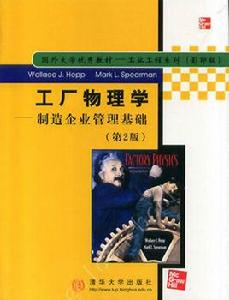內容簡介
《工廠物理學》的作者是美國西北大學的W.J.Hopp教授和喬治亞理工學院的M.L.Spearman教授,是生產運作管理領域的知名學者,都是學物理出身,在多年實踐經驗和理論研究的基礎上,以獨特的視角與思維方式對發生在製造企業中的現象和本質進行了透徹的分析和系統的總結,以類似於物理學中定律定理的方式給出了準確的定性描述或定量計算公式。書中不僅對生產管理的發展歷史和現狀、取得的成就和問題等進行了精闢的總結和分析,而且緊密跟蹤當前最先進的方法和技術,並預測了今後的發展趨勢。
該書不同於一般的教科書,一方面涉獵範圍極寬,廣泛介紹了生產領域的概念、方法、技術及實踐效果;另一方面對重點問題進行了極為深入細緻的研究,探究了事物的本質,提出了獨到的見解。該書的起點較高,適合作為“生產系統”和“運作管理”方面的研究生課程的主教材。對本科生教學,可以作為“生產運作管理”、“生產計畫與控制”、“設施規劃與物流分析”、“質量管理”等課程的主要參考書。
編輯推薦
《工廠物理學:製造企業管理基礎》(第2版影印版)不同於一般的教科書,一方面涉獵範圍極寬,廣泛介紹了生產領域的概念、方法、技術及實踐效果;另一方面對重點問題進行了極為深入細緻的研究,探究了事物的本質,提出了獨到的見解。該書的起點較高,適合作為"生產系統"和"運作管理"方面的研究生課程的主教材。對本科生教學,可以作為"生產運作管理"、"生產計畫與控制"、"設施規劃與物流分析"、"質量管理"等課程的主要參考書。
目錄
0 Factory Physics?
0.1 The Short Answer
0.2 The Long Answer
0.2.1 Focus:Manufacturing Management
0.2.2 Scope:Operations
0.2.3 Method:Factory Physics
0.2.4 Perspective:Flow Lines
0.3 An Overview of the Book
PART I THE LESSONS OF HISTORY
1 Manufacturing in America
1.1 Introduction
1.2 The American Experience
1.3 The First Industrial Revolution
1.3.1 The Industrial Revolution in America
1.3.2 The American System of Manufacturing
1.4 The Second Industrial Revolution
1.4.1 The Role of the Railroads
1.4.2 Mass Retailers
1.4.3 Andrew Carnegie and Scale
1.4.4 Henry Ford and Speed
1.5 Scientific Management
1.5.1 Frederick W.Taylor
1.5.2 Planning versus Doing
1.5.3 Other Pioneers of Scientific Management
1.5.4 The Science of Scientific Management
1.6 The Rise of the Modern Manufacturing Organization
1.6.1 Du Pont,Sloan,and Structure
1.6.2 Hawthorne and the Human Element
1.6.3 Management Education
1.7 Peak,Decline,and Resurgence of American Manufacturing
1.7.1 The Golden Era
1.7.2 Accountants Count and Salesment Sell
1.7.3 The Professional Manager
1.7.4 Recovery and Globalization of Manufacturing
1.8 The Future
Discussion Points
Study questions
2 Inventory Control:From EOQ to ROP
2.1 Introduction
2.2 The Economic Order Quantity Model
2.2.1 Motivation
2.2.2 The Model
2.2.3 The Key Insight of EOQ
2.2.4 Sensitivity
2.2.5 EOQ Extensions
2.3 Dynamic Lot Sizing
2.3.1 Motivation
2.3.2 Problem Formulation
2.3.3 The Wagner-Whitin Procedure
2.3.4 Interpreting the Solution
2.3.5 Caveats
2.4 Statistical Inventory Models
2.4.1 The News Vendor Model
2.4.2 The Base Stock Model
2.4.3 The Model
2.5 Conclusions
Appendix 2A Basic Probability
Appendix 2B Inventory Formulas
Study Questions
Problems
3 The MRP Crusade
3.1 Material Requirements Planning-MRP
3.1.1 The Key Insight of MRP
3.1.2 Overview of MRP
3.1.3 MRP Inputs and Outputs
3.1.4 The MRP Procedure
3.1.5 Special Topics in MRP
3.1.6 Lot Sizing in MRP
3.1.7 Safety Stock and Safety Lead Times
3.1.8 Accommodating Yield Losses
3.1.9 Problems in MRP
3.2 Manufacturing Resources Planning-MRP II
3.2.1 The MRP II Hierarchy
3.2.2 Long-Range Planning
3.2.3 Intermediate Planning
3.2.4 Short-Term Control
3.3 Beyond MRP II-Enterprise Resources Planning
3.3.1 History and Success of ERP
3.3.2 An Example:SAP R/3
3.3.3 Manufacturing Execution Systems
3.3.4 Advanced Planning Systems
3.4 Conclusions
Study Questions
Problems
4 The JIT Revolution
4.1 The Origins of JIT
4.2 JIT Goals
4.3 The Environment as a Control
4.4 Implementing JIT
4.4.1 Production Smoothing
4.4.2 Capacity Buffers
4.4.3 Setup Reduction
4.4.4 Cross-Training and Plant Layout
4.4.5 Total Quality Management
4.5 Kanban
4.6 The Lessons of JIT
Discussion Point
Study Questions
5 What Went Wrong
5.1 Introduction
5.2 Trouble with Scientific Management
5.3 Trouble with MRP
5.4 Trouble with JIT
5.5 Where from Here?
Discussion Points
Study Questions
PART II FACTORY PHYSICS
6 A Science of Manufacturing
6.1 The Seeds of Science
6.1.1 Why Science?
6.1.2 Defining a Manufacturing System
6.1.3 Prescriptive and Descriptive Models
6.2 Objectives,Measures,and Controls
6.2.1 The Systems Approach
6.2.2 The Fundamental Objective
6.2.3 Hierarchical Objectives
6.2.4 Control and Information Systems
6.3 Models and Performance Measures
6.3.1 The Danger of Simple Models
6.3.2 Building Better Prescriptive Models
6.3.3 Accounting Models
6.3.4 Tactical and Strategic Modeling
6.3.5 Considering
6.4 Conclusions
Appendix 6A Activity-Based Costing
Study Questions
Problems
7 Basic Factory Dynamics
7.1 Introduction
7.2 Definitions and Parameters
7.2.1 Definitions
7.2.2 Parameters
7.2.3 Examples
7.3 Simple Relationships
7.3.1 Best-Case Performance
7.3.2 Worst-Case Performance
7.3.3 Practical Worst-Case Performance
7.3.4 Bottleneck Pates and Cycle Time
7.3.5 Internal Benchmarking
7.4 Labor-Constrained Systems
7.4.1 Ample Capacity Case
7.4.2 Ful Flexibility Case
7.4.3 CONWIP Lines with Flexible Labor
7.5 Conclusions
Study Questions
Problems
Intuition-Building Exercises
8 Variabiity Basics
8.1 Introduction
8.2 Variability and Randomness
8.2.1 The Roots of Randomness
8.2.2 Probabilistic Intuition
8.3 Process Time Variability
8.3.1 Measures and Classes of Varibability
8.3.2 Low and Moderate Variability
8.3.3 Highly Variable Process Times
8.4 Causes of Variability
8.4.1 Natural Variability
8.4.2 Variability from Preemptive Outages(Breakdowns)
8.4.3 Variability from Nonpreemptive Outages
8.4.4 Variability from Recycle
8.4.5 Summary of Variability Formulas
8.5 Flow Variability
8.5.1 Characterizing Variability in Flows
8.5.2 Batch Arrivals and Departures
8.6 Variability Interactions-Queueing
8.6.1 Queueing Notation and Measures
8.6.2 Fundamental Relations
8.6.3 The M/M/1 Queue
8.6.4 Performance Measures
8.6.5 Systems with General Process and Interarrival Times
8.6.6 Parallel Machines
8.6.7 Parallel Machines and General Times
8.7 Effects of Blocking
8.7.1 The M/M/1/b Queue
8.7.2 General Blocking Models
8.8 Variability Pooling
8.8.1 Batch Processing
8.8.2 Safety Stock Aggregation
8.8.3 Queue Sharing
8.9 Conclusions
Study Questions
Problems
9 The Corrupting Influence of Variability
9.1 Introduction
9.1.1 Can Variability Be Good?
9.1.2 Examples of Good and Bad Variability
9.2 Performance and Variability
9.2.1 Measures of Manufacturing Performance
9.2.2 Variability Laws
9.2.3 Buffering Examples
9.2.4 Pay Me Now or Pay Me Later
9.2.5 Flexibility
9.2.6 Organizational Learning
9.3 Flow Laws
9.3.1 Product Flows
9.3.2 Capacity
9.3.3 Utilization
9.3.4 Variability and Flow
9.4 Batching Laws
9.4.1 Types of Batches
9.4.2 Process Batching
9.4.3 Move Batching
9.5 Cycle Time
9.5.1 Cycle Time at a Single Station
9.5.2 Assembly Operations
9.5.3 Line Cycle Time
9.5.4 Cycle Time,Lead Time,and Service
9.6 Diagnostics and Improvement
9.6.1 Increasing Throughput
9.6.2 Reducing Cycle Time
9.6.3 Improving Customer Service
9.7 Conclusions
Study Questions
Intuition-Building Exercises
Problems
10 Push and Pull Production Systems
10.1 Introduction
10.2 Definitions
10.2.1 The Key Difference between Push and Pull
10.2.2 The Push-Pull Interface
10.3 The Magic of Pull
10.3.1 Reducing Manufacturing Costs
10.3.2 Reducing Variability
10.3.3 Improving Quality
10.3.4 Maintaining Flexibility
10.3.5 Facilitating Work Ahead
10.4 CONWIP
10.4.1 Basic Mechanics
10.4.2 Mean-Value Analysis Model
10.5 Comparisons of CONWIP with MRP
10.5.1 Observability
10.5.2 Efficiency
10.5.3 Variability
10.5.4 Robustness
10.6 Comparisons of CONWIP with Kanban
10.6.1 Card Count Issues
10.6.2 Product Mix Issues
10.6.3 People Issues
10.7 Conclusions
Study Question
Problems
11 The Human Element in Operations Management
11.1 Introduction
11.2 Basic Human Laws
11.2.1 The Foundation of Self-interest
11.2.2 The Fact of Diversity
11.2.3 The Power of Zealotry
11.2.4 The Reality of Burnout
11.3 Planning versus Motivating
11.4 Responsibility and Authority<BR ……

